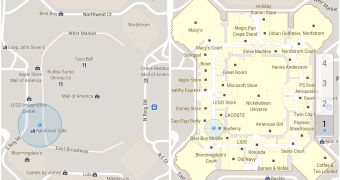Google is now taking the next logical step for Google Maps. After covering pretty much all of the surface of the Earth, with varying degrees of detail, it is now tackling indoor locations.
The idea is to help you navigate indoors as easily as outdoors. This is especially useful for large locations and unknown places obviously, but it should come in very handy in several types of places in particular, airports, malls, big institutions and so on.
Unsurprisingly, that's what Google is starting with. For now, there isn't a whole lot of indoor data, so the feature will be useful in just a handful of locations. But the idea behind it is solid and, in time, Google should be able to add more and more locations in time.
"When you’re inside an airport, shopping mall or retail store, a common way to figure out where you are is to look for a freestanding map directory or ask an employee for help," Brian McClendon, VP of Engineering, Google Earth and Maps, wrote.
"Starting today, with the release of Google Maps 6.0 for Android, that directory is brought to the palm of your hands, helping you determine where you are, what floor you're on, and where to go indoors," he said.
The feature only works on mobile devices, well, it only works on Android devices running the latest Maps app. It's also limited to a few places. But Google will probably expand it to the web version soon enough.
Where it does work, the interior map will load automatically and you'll even have an indicator pinpointing your location within the building. What's great, with the location feature enabled, Maps will even know what floor you're on and show the map accordingly.
A big hurdle of course is that you can't really 'map' interior locations as easily as you do the outdoors. For one, mapping data already exists for much of the world and where there aren't enough details, satellite imagery provides a starting point.
But interior location are much harder to map, you need to work with a lot more companies, organizations and institutions to get all of the data. Google is enabling businesses to provide their own floorplans, blueprints and anything else that can be used to create a map of the place.
Even with a complete map, you still need to go to each place and extract the relevant data to make sure My Location works there as well.
GPS doesn't work indoors so the only other reliable means of determining location are WiFi routers. But there aren't any Street View cars running inside buildings, so Google has probably had to map out the location of each router in a building to create a location database, since this seems to be the method used for interior locations.

 14 DAY TRIAL //
14 DAY TRIAL // 